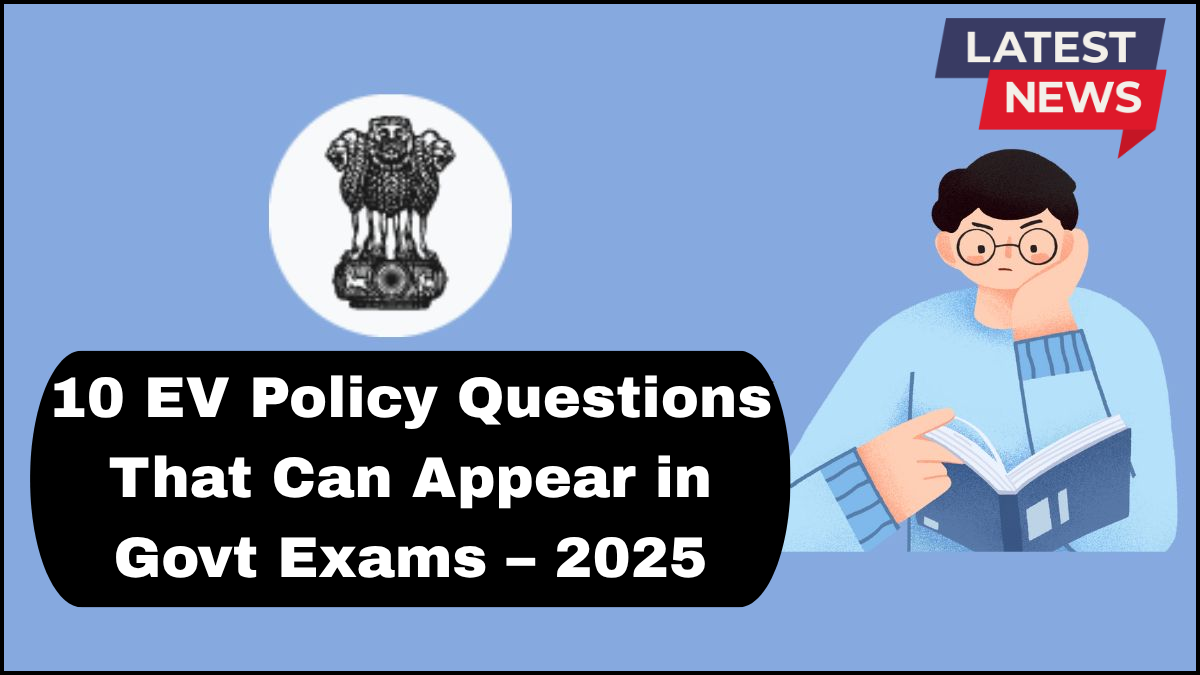With the electric vehicle (EV) sector accelerating rapidly in India, government EV scheme questions are increasingly finding their way into competitive exams. Aspirants preparing for UPSC, SSC, Railways, or state-level government exams must now stay updated with 2025 policy highlights related to India’s EV roadmap. Below are ten essential questions that could appear in upcoming exams, explained in detail to boost your understanding.

1. What is the FAME India Scheme?
The Faster Adoption and Manufacturing of Hybrid and Electric Vehicles (FAME) India Scheme is a central initiative launched to promote electric mobility. Currently in its second phase (FAME II), it offers subsidies for electric two-wheelers, three-wheelers, and four-wheelers. The goal is to reduce dependency on fossil fuels and cut vehicular emissions. FAME II has been extended until March 2024, with a possible continuation into 2025 under revised terms.
2. How Does the PLI Scheme Support EV Manufacturing?
The Production Linked Incentive (PLI) scheme provides financial incentives to manufacturers producing Advanced Chemistry Cell (ACC) batteries and other key EV components. This policy aims to boost local manufacturing, reduce import dependence, and attract major investments in the clean mobility space. It’s an important topic among 2025 policy highlights for EVs.
3. What Are the Key Features of the National Electric Mobility Mission Plan (NEMMP)?
Launched in 2013, the NEMMP 2020 laid the foundation for India’s EV policy landscape. It aimed to achieve fuel savings of 9500 million liters and reduce greenhouse gas emissions by 2 million tonnes. Although the original targets were set for 2020, the mission’s vision continues to influence newer initiatives such as FAME and state EV policies.
4. Which States Have Their Own EV Policies?
Several Indian states have introduced independent EV policies. States like Maharashtra, Delhi, Tamil Nadu, and Gujarat offer purchase incentives, tax exemptions, and subsidies on charging infrastructure. For example, Delhi’s EV Policy 2020 aims to make 25% of new vehicle registrations electric by 2024. These policies often reflect the broader national goals while addressing local mobility needs.
5. What Role Does NITI Aayog Play in EV Policy Planning?
NITI Aayog, India’s premier policy think tank, actively collaborates with ministries to shape EV-related decisions. It has proposed a phased transition to electric two- and three-wheelers by 2030 and is instrumental in developing battery swapping guidelines, a crucial part of EV infrastructure.
6. What Are Battery Swapping and Its Policy Implications?
Battery swapping allows users to exchange a discharged battery with a charged one at designated stations. This eliminates long charging times and is vital for commercial EV fleets. The draft Battery Swapping Policy, expected to be finalized in 2025, promotes interoperability and standardized battery formats.
7. How Are Charging Infrastructure Challenges Being Addressed?
The Ministry of Power and the Bureau of Energy Efficiency (BEE) are working to set up EV charging stations across national highways and urban centers. Guidelines mandate that charging stations be available every 25 km on highways and in all major cities, aligning with the long-term EV ecosystem vision.
8. What Is the Role of the GST Structure in Promoting EVs?
EVs attract a GST of just 5%, compared to 28% for conventional vehicles. Additionally, buyers can claim income tax deductions under Section 80EEB on interest paid for EV loans. These financial measures support the affordability and uptake of electric vehicles.
9. How Does India Plan to Localize EV Supply Chains?
With geopolitical tensions and a global push for self-reliance, India aims to localize EV supply chains by promoting domestic battery production, electric drivetrain manufacturing, and rare earth material processing. The PLI scheme for ACC batteries and the Make in India campaign are core drivers.
10. What Are the 2025 Policy Highlights to Watch For?
In 2025, the government is expected to:
- Expand FAME II or introduce FAME III
- Finalize the Battery Swapping Policy
- Launch incentives for electric buses
- Push for 100% EV adoption in public transport fleets
- Mandate EV-compatible building codes These changes will likely dominate government EV scheme questions in future exams.
FAQs
Q1. Will EV-related questions appear in all government exams?
Yes, due to their national importance, questions related to EV schemes and policies are increasingly featured in general awareness and current affairs sections.
Q2. Which document should I read for updated EV policy information?
Refer to government press releases, PIB updates, and official policy documents from NITI Aayog, Ministry of Heavy Industries, and the Ministry of Power.
Q3. What kind of EV-related questions are asked?
Expect MCQs on schemes like FAME, state-level policies, incentives, tax benefits, infrastructure plans, and government targets for EV adoption.
Q4. Is the battery swapping policy implemented yet?
As of 2025, it is still in draft form but expected to be finalized and adopted soon.
click here to learn more